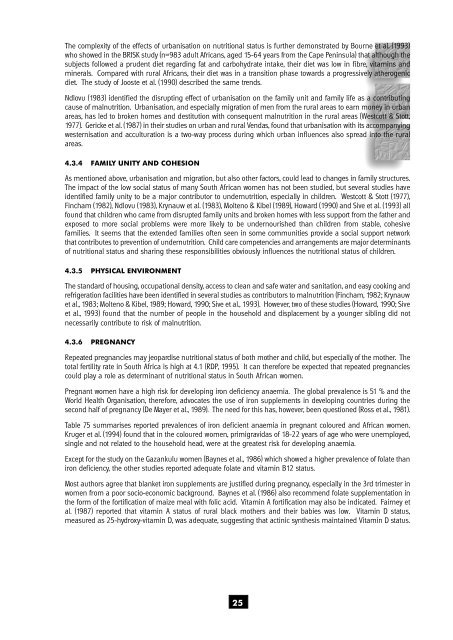the nutritional status of - Health Systems Trust
the nutritional status of - Health Systems Trust
the nutritional status of - Health Systems Trust
Create successful ePaper yourself
Turn your PDF publications into a flip-book with our unique Google optimized e-Paper software.
The complexity <strong>of</strong> <strong>the</strong> effects <strong>of</strong> urbanisation on <strong>nutritional</strong> <strong>status</strong> is fur<strong>the</strong>r demonstrated by Bourne et al. (1993)<br />
who showed in <strong>the</strong> BRISK study (n=983 adult Africans, aged 15-64 years from <strong>the</strong> Cape Peninsula) that although <strong>the</strong><br />
subjects followed a prudent diet regarding fat and carbohydrate intake, <strong>the</strong>ir diet was low in fibre, vitamins and<br />
minerals. Compared with rural Africans, <strong>the</strong>ir diet was in a transition phase towards a progressively a<strong>the</strong>rogenic<br />
diet. The study <strong>of</strong> Jooste et al. (1990) described <strong>the</strong> same trends.<br />
Ndlovu (1983) identified <strong>the</strong> disrupting effect <strong>of</strong> urbanisation on <strong>the</strong> family unit and family life as a contributing<br />
cause <strong>of</strong> malnutrition. Urbanisation, and especially migration <strong>of</strong> men from <strong>the</strong> rural areas to earn money in urban<br />
areas, has led to broken homes and destitution with consequent malnutrition in <strong>the</strong> rural areas (Westcott & Stott,<br />
1977). Gericke et al. (1987) in <strong>the</strong>ir studies on urban and rural Vendas, found that urbanisation with its accompanying<br />
westernisation and acculturation is a two-way process during which urban influences also spread into <strong>the</strong> rural<br />
areas.<br />
4.3.4 FAMILY UNITY AND COHESION<br />
As mentioned above, urbanisation and migration, but also o<strong>the</strong>r factors, could lead to changes in family structures.<br />
The impact <strong>of</strong> <strong>the</strong> low social <strong>status</strong> <strong>of</strong> many South African women has not been studied, but several studies have<br />
identified family unity to be a major contributor to undernutrition, especially in children. Westcott & Stott (1977),<br />
Fincham (1982), Ndlovu (1983), Krynauw et al. (1983), Molteno & Kibel (1989), Howard (1990) and Sive et al. (1993) all<br />
found that children who came from disrupted family units and broken homes with less support from <strong>the</strong> fa<strong>the</strong>r and<br />
exposed to more social problems were more likely to be undernourished than children from stable, cohesive<br />
families. It seems that <strong>the</strong> extended families <strong>of</strong>ten seen in some communities provide a social support network<br />
that contributes to prevention <strong>of</strong> undernutrition. Child care competencies and arrangements are major determinants<br />
<strong>of</strong> <strong>nutritional</strong> <strong>status</strong> and sharing <strong>the</strong>se responsibilities obviously influences <strong>the</strong> <strong>nutritional</strong> <strong>status</strong> <strong>of</strong> children.<br />
4.3.5 PHYSICAL ENVIRONMENT<br />
The standard <strong>of</strong> housing, occupational density, access to clean and safe water and sanitation, and easy cooking and<br />
refrigeration facilities have been identified in several studies as contributors to malnutrition (Fincham, 1982; Krynauw<br />
et al., 1983; Molteno & Kibel, 1989; Howard, 1990; Sive et al., 1993). However, two <strong>of</strong> <strong>the</strong>se studies (Howard, 1990; Sive<br />
et al., 1993) found that <strong>the</strong> number <strong>of</strong> people in <strong>the</strong> household and displacement by a younger sibling did not<br />
necessarily contribute to risk <strong>of</strong> malnutrition.<br />
4.3.6 PREGNANCY<br />
Repeated pregnancies may jeopardise <strong>nutritional</strong> <strong>status</strong> <strong>of</strong> both mo<strong>the</strong>r and child, but especially <strong>of</strong> <strong>the</strong> mo<strong>the</strong>r. The<br />
total fertility rate in South Africa is high at 4.1 (RDP, 1995). It can <strong>the</strong>refore be expected that repeated pregnancies<br />
could play a role as determinant <strong>of</strong> <strong>nutritional</strong> <strong>status</strong> in South African women.<br />
Pregnant women have a high risk for developing iron deficiency anaemia. The global prevalence is 51 % and <strong>the</strong><br />
World <strong>Health</strong> Organisation, <strong>the</strong>refore, advocates <strong>the</strong> use <strong>of</strong> iron supplements in developing countries during <strong>the</strong><br />
second half <strong>of</strong> pregnancy (De Mayer et al., 1989). The need for this has, however, been questioned (Ross et al., 1981).<br />
Table 75 summarises reported prevalences <strong>of</strong> iron deficient anaemia in pregnant coloured and African women.<br />
Kruger et al. (1994) found that in <strong>the</strong> coloured women, primigravidas <strong>of</strong> 18-22 years <strong>of</strong> age who were unemployed,<br />
single and not related to <strong>the</strong> household head, were at <strong>the</strong> greatest risk for developing anaemia.<br />
Except for <strong>the</strong> study on <strong>the</strong> Gazankulu women (Baynes et al., 1986) which showed a higher prevalence <strong>of</strong> folate than<br />
iron deficiency, <strong>the</strong> o<strong>the</strong>r studies reported adequate folate and vitamin B12 <strong>status</strong>.<br />
Most authors agree that blanket iron supplements are justified during pregnancy, especially in <strong>the</strong> 3rd trimester in<br />
women from a poor socio-economic background. Baynes et al. (1986) also recommend folate supplementation in<br />
<strong>the</strong> form <strong>of</strong> <strong>the</strong> fortification <strong>of</strong> maize meal with folic acid. Vitamin A fortification may also be indicated. Fairney et<br />
al. (1987) reported that vitamin A <strong>status</strong> <strong>of</strong> rural black mo<strong>the</strong>rs and <strong>the</strong>ir babies was low. Vitamin D <strong>status</strong>,<br />
measured as 25-hydroxy-vitamin D, was adequate, suggesting that actinic syn<strong>the</strong>sis maintained Vitamin D <strong>status</strong>.<br />
25
















